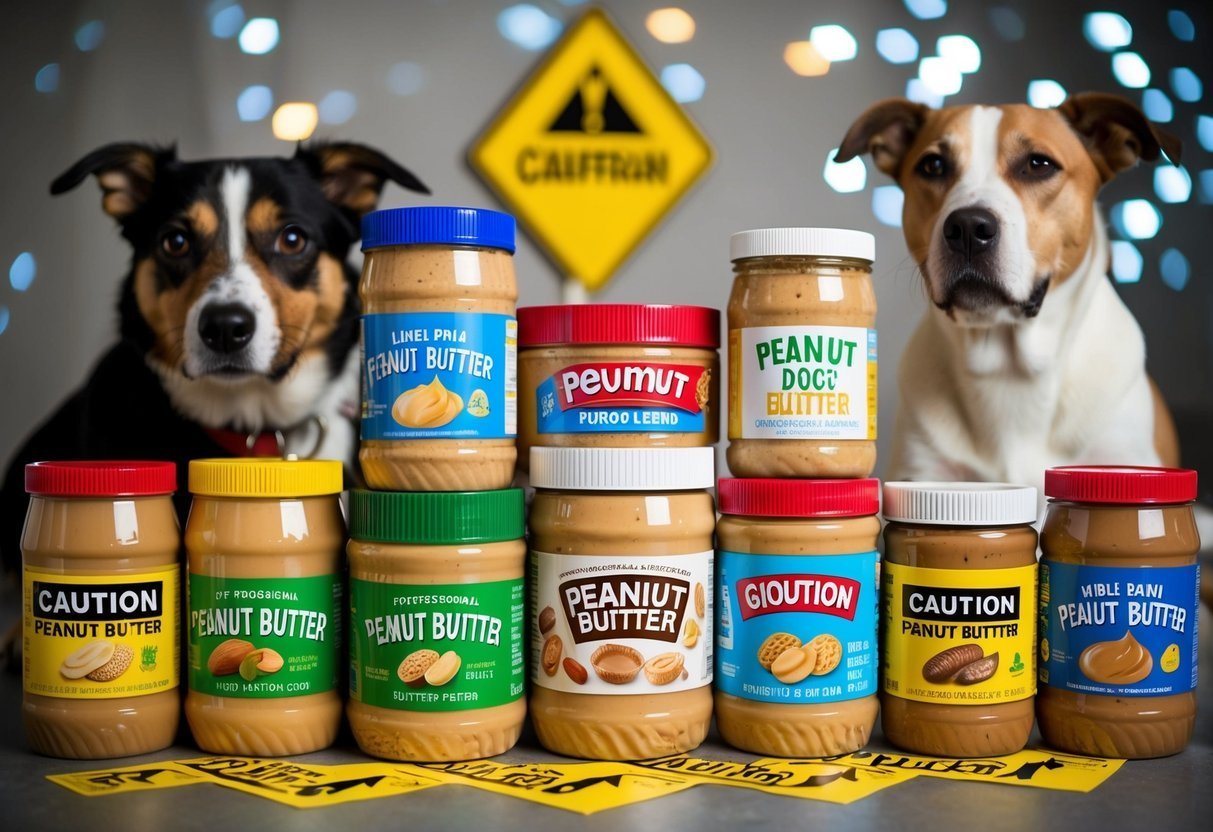When it comes to treating your furry friend, peanut butter is often a go-to option.
However, not all peanut butter is safe for dogs.
Some brands and types can contain harmful ingredients that could put your dog’s health at risk.
As a responsible dog owner, you want to ensure you’re choosing the right snacks.
This article will highlight eight types of peanut butter that you should avoid to keep your pup safe and healthy.
Understanding what to look out for can make a big difference in your dog’s well-being.
1) Skippy Reduced Fat Peanut Butter
Skippy Reduced Fat Peanut Butter might seem like a tasty treat for your dog, but there are some concerns.
While it has 25% less fat than regular peanut butter, it still contains ingredients that aren’t safe for dogs.
The product includes corn syrup solids and hydrogenated oils.
These additives can lead to digestive issues in dogs.
Sugar can also be harmful over time, especially for pups prone to obesity or diabetes.
Additionally, some peanut butters have xylitol, a sweetener that is extremely toxic to dogs.
Always check the label before sharing any peanut butter with your furry friend.
Even though it has fewer calories, it’s best to limit treats like Skippy.
Consider using natural peanut butters with just peanuts and salt for a safer option.
Stick to small amounts, and monitor your dog for any unusual reactions.
2) Jif Natural Peanut Butter Spread
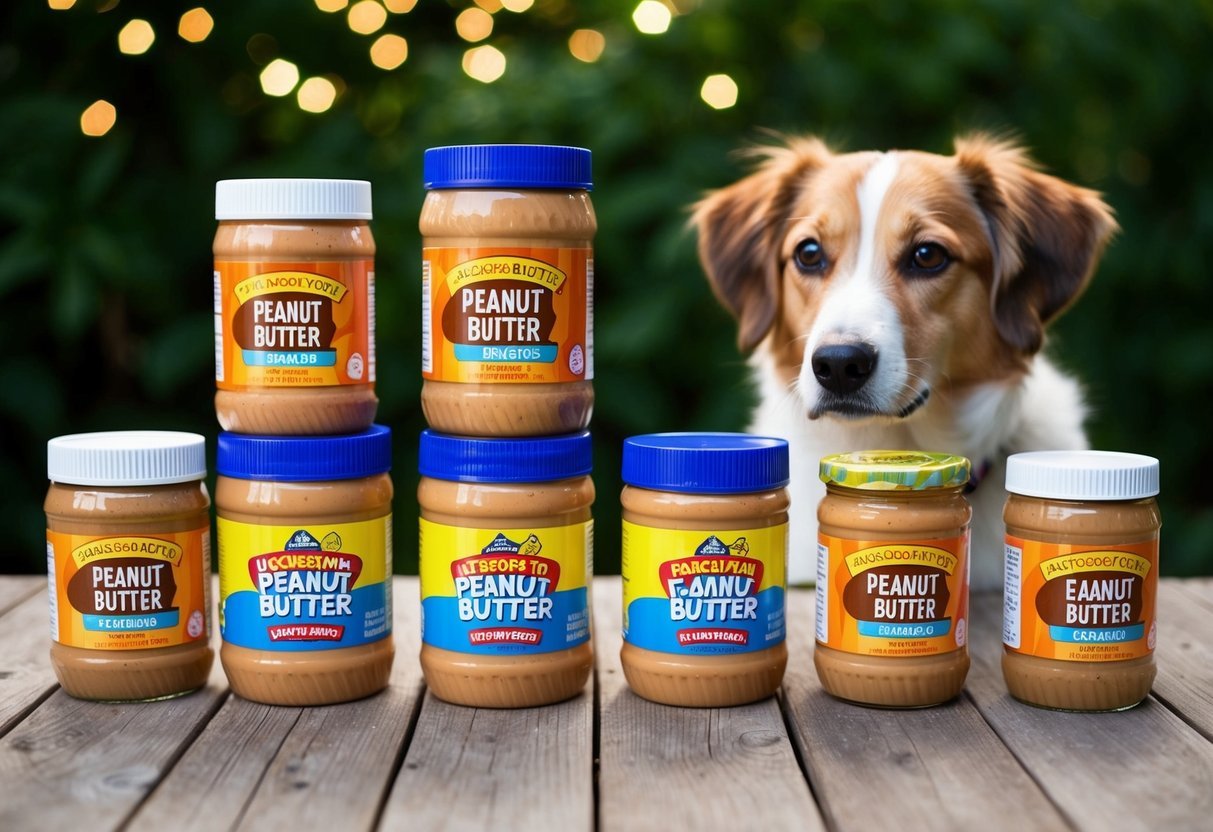
Jif Natural Peanut Butter Spread is a popular choice for many.
It’s made from roasted peanuts and has a smooth texture that many people enjoy.
While it doesn’t contain xylitol, which is toxic to dogs, it still has added sugars and palm oil.
These ingredients can upset your dog’s stomach if consumed in large amounts.
You might think it’s a healthy option, but it’s best to avoid giving it to your dog.
Natural doesn’t always mean safe for furry friends.
If your dog accidentally eats a small amount, watch for any signs of discomfort.
Always choose peanut butter specifically made for dogs to ensure their safety.
3) Peter Pan Creamy Peanut Butter with Honey
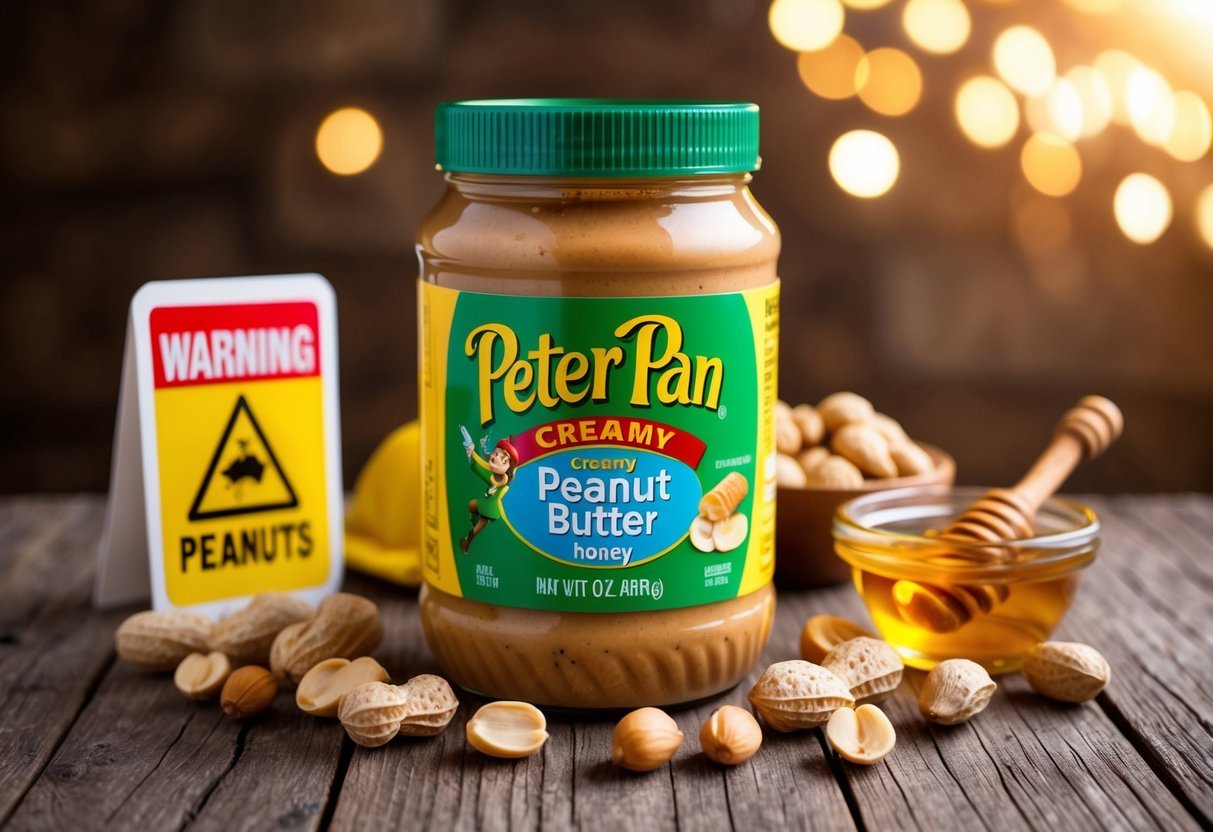
Peter Pan Creamy Peanut Butter with Honey might seem like a treat, but it has some ingredients that aren’t safe for dogs.
This peanut butter is sweetened with honey, which can add extra sugar to your pet’s diet.
While a small amount might not cause immediate harm, the sugar can lead to weight gain and other health issues.
Regular consumption can put your dog at risk for diabetes.
Additionally, many peanut butters, including Peter Pan, often contain added salt.
Too much salt isn’t good for your dog’s heart and kidneys.
It’s important to choose peanut butter without added sugars or salts for your dog.
Always check the label before sharing any human food with your pup.
If you want to treat your dog, look for naturally made peanut butters.
These are safe and healthy options for your furry friend.
Stick to simple ingredients that won’t upset your dog’s stomach.
Nutella (yes, it’s not technically peanut butter, but still dangerous)
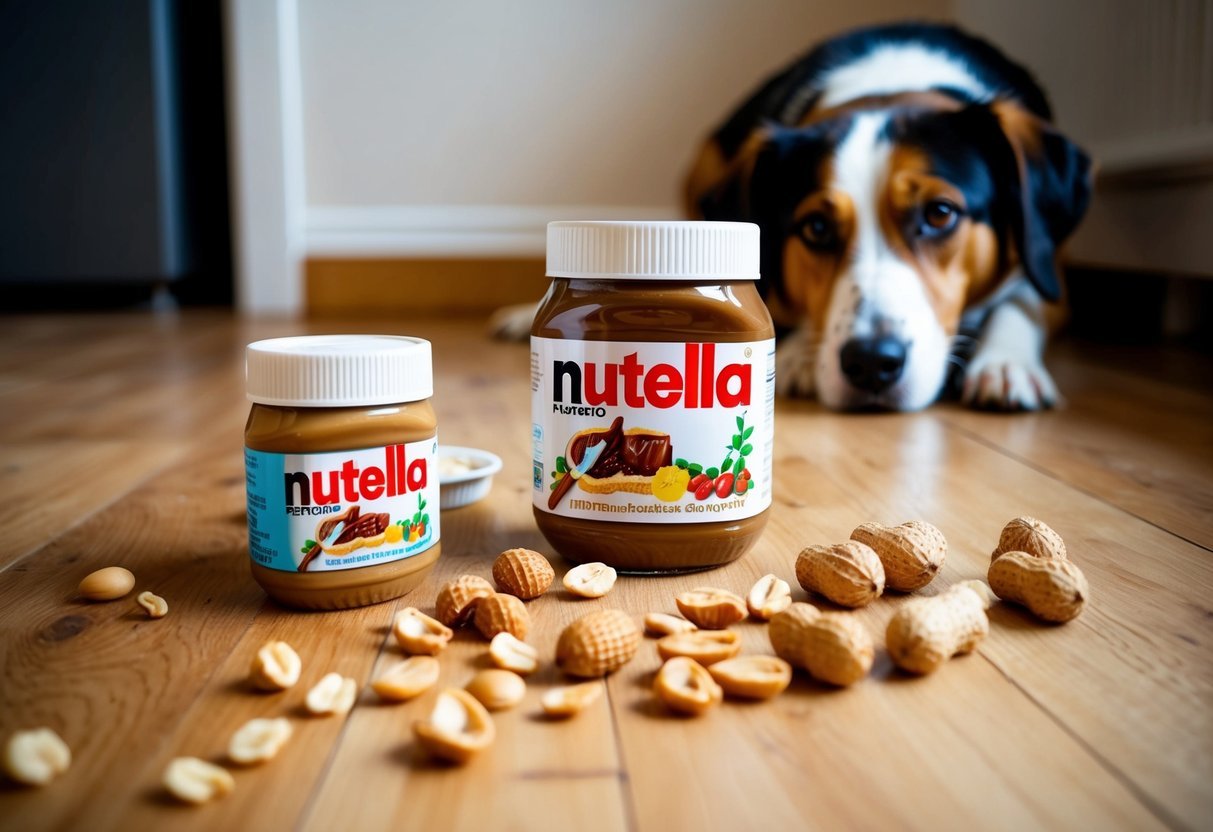
You might think Nutella is a tasty treat for yourself, but it’s not safe for your dog.
Nutella is a chocolate-hazelnut spread that contains high amounts of sugar and fat.
The real issue is the chocolate in Nutella.
Chocolate is toxic to dogs and can lead to serious health problems.
Even a small amount can cause symptoms like vomiting, diarrhea, and increased heart rate.
Nutella also has a lot of added sugar.
Too much sugar can be harmful to dogs and may lead to obesity and other health issues.
Plus, the fats can upset their stomach, leading to more discomfort.
Always keep this sweet spread out of your dog’s reach.
Just because it’s not peanut butter doesn’t mean it’s safe.
Your pup’s health should be the priority, so choose dog-friendly snacks instead.
5) Reese’s Creamy Peanut Butter
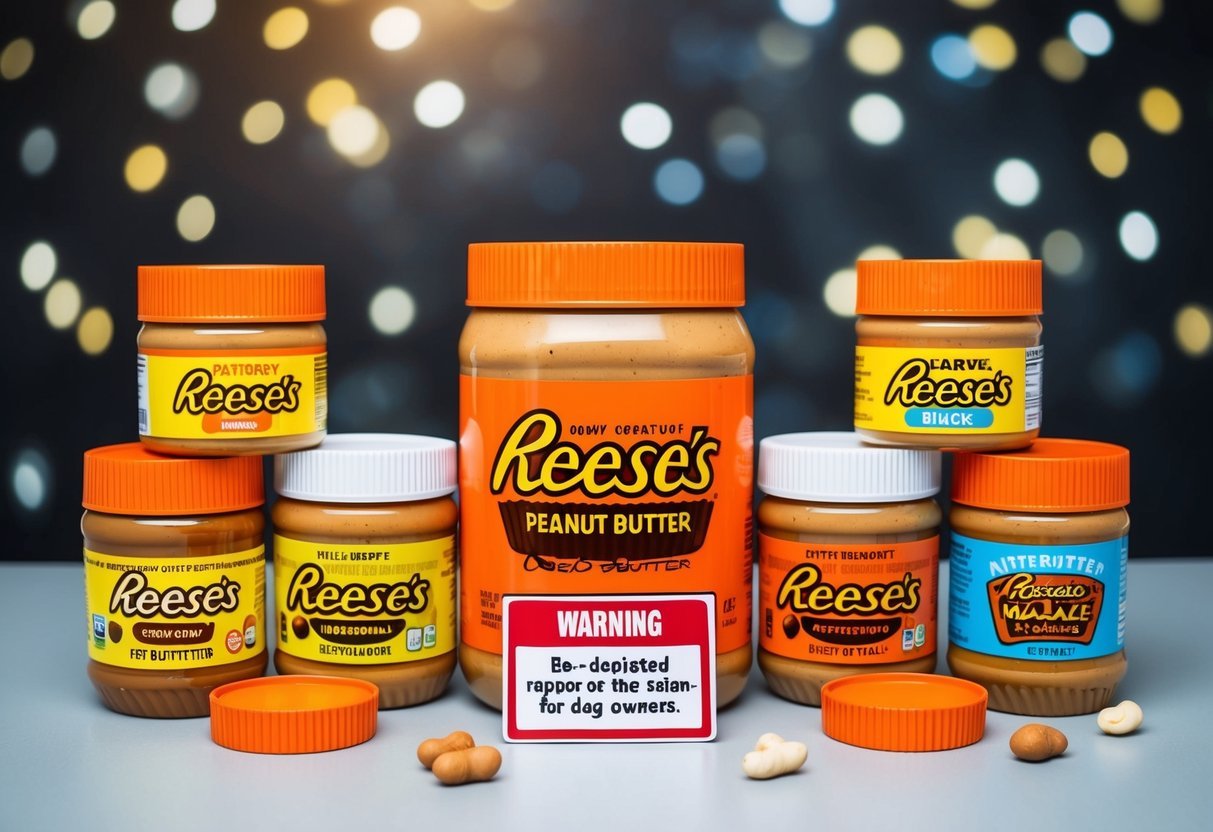
Reese’s Creamy Peanut Butter is popular for its sweet taste and smooth texture.
While it’s great for spreading on toast or using in recipes, it’s not safe for dogs.
Like many peanut butters, Reese’s contains added sugar and fats.
These ingredients can upset your dog’s stomach and contribute to weight gain.
The main concern with Reese’s is chocolate.
Chocolate is toxic to dogs.
Since Reese’s peanut butter is often associated with chocolate products, it’s easy to see why you should be careful.
Even a small amount could lead to health issues for your pet.
Symptoms of chocolate poisoning include vomiting, diarrhea, and increased heart rate.
Always check labels before sharing any peanut butter with your furry friend.
Choosing dog-safe options that contain no sugar or xylitol is the best choice.
6) Smucker’s Natural Peanut Butter
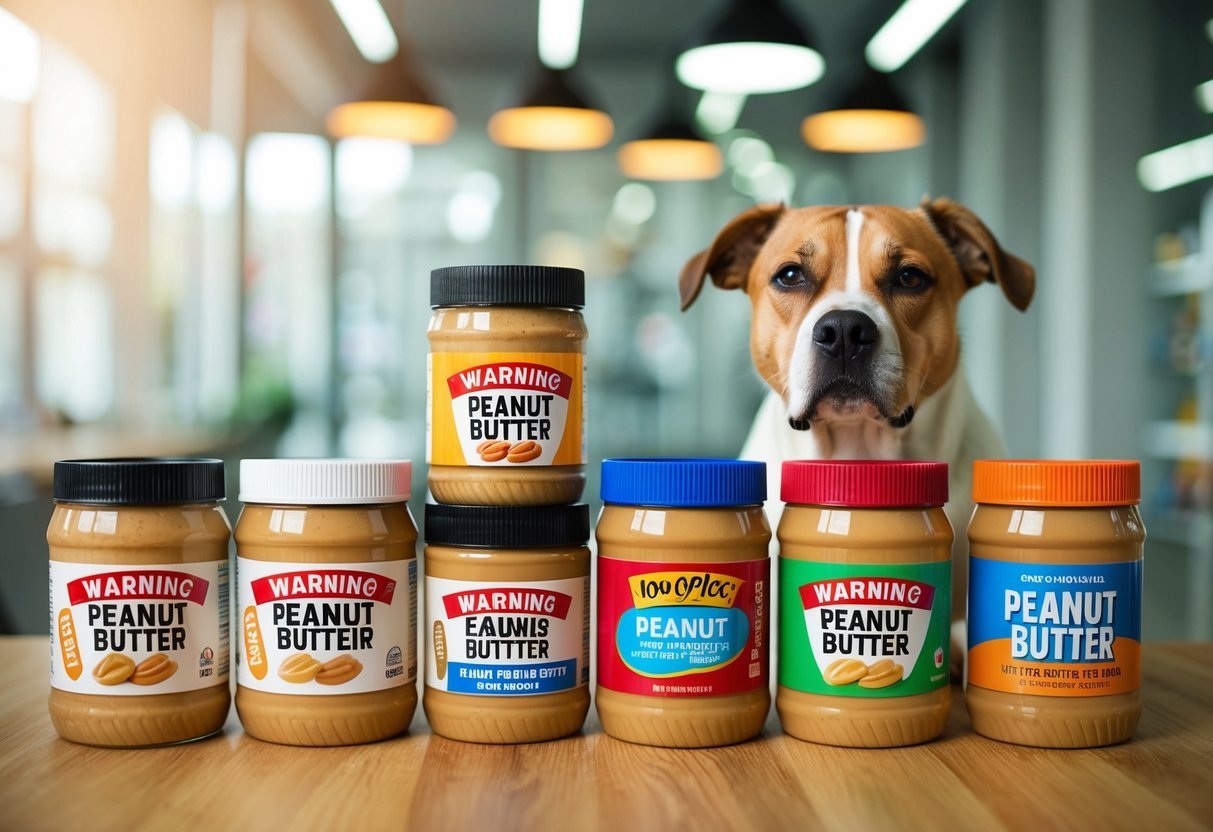
Smucker’s Natural Peanut Butter is a popular choice among many dog owners.
It is made with just two simple ingredients: peanuts and a dash of salt.
This clean formula makes it easy to know what you’re giving your furry friend.
While it may seem safe, not all peanut butter is dog-friendly.
The added salt could be a concern if your dog consumes it in large amounts.
Salt can lead to health issues like dehydration or kidney problems in pets.
Make sure to read the label carefully.
Some versions may have added sugars or unhealthy fats, which you want to avoid.
For a treat, always use Smucker’s Natural Peanut Butter sparingly to keep your dog healthy.
If your dog has a peanut allergy, stay away from this option completely.
Always consult with your vet if you’re unsure about giving peanut butter to your dog.
Your pet’s health is what matters most!
7) Justin’s Maple Almond Butter (includes xylitol)
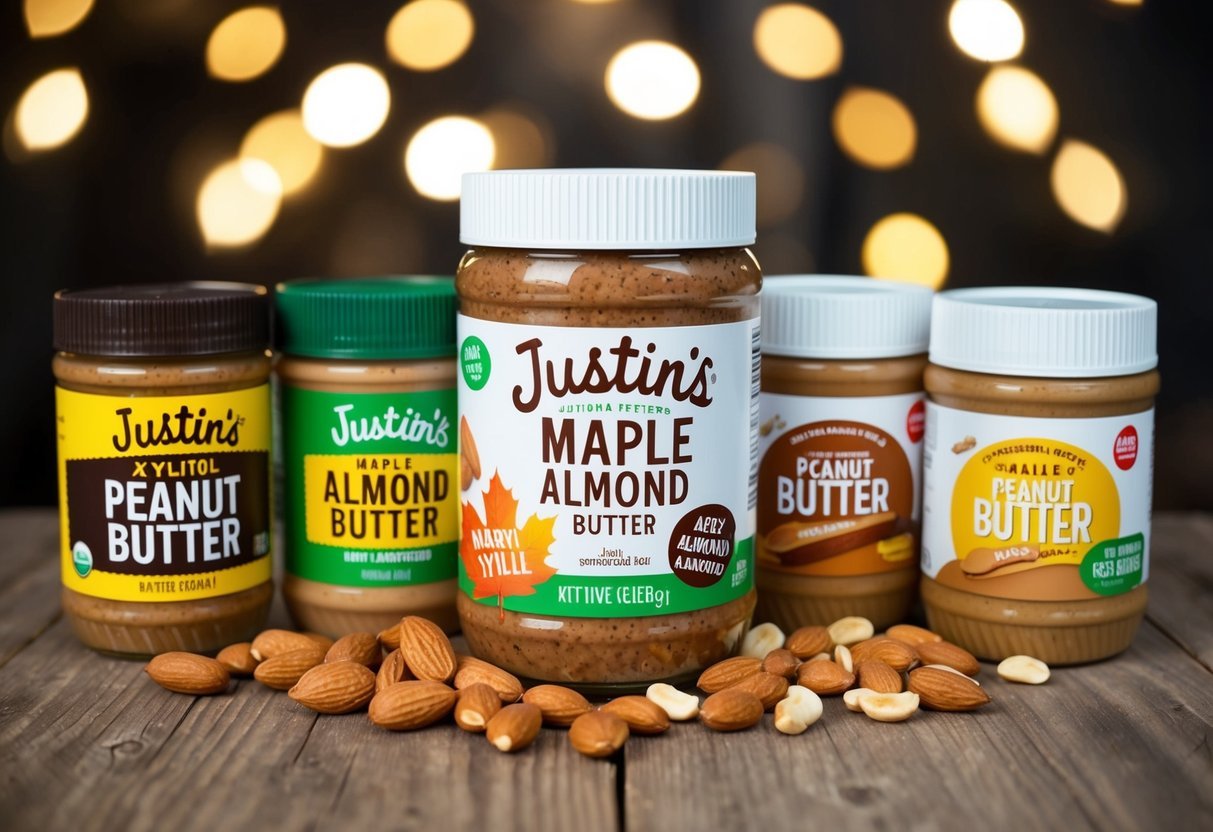
Justin’s Maple Almond Butter is a tasty spread, but it can be dangerous for dogs.
Some varieties of this brand may contain xylitol, a sweetener that can be harmful to pets.
Xylitol can cause a rapid drop in blood sugar levels in dogs, leading to serious health issues.
Symptoms can include vomiting, loss of coordination, and even seizures.
In severe cases, it may lead to liver failure.
Always check the ingredient list before sharing any food with your dog.
If you have Justin’s Maple Almond Butter, make sure it doesn’t have xylitol in it.
Remember, it’s best to keep this spread away from your furry friend for their safety.
You want to keep your dog healthy, so it’s smart to be cautious with treats.
Choose peanut butters specifically made for dogs, which are safe and free of harmful ingredients.
8) Crazy Richard’s Peanut Butter Powder
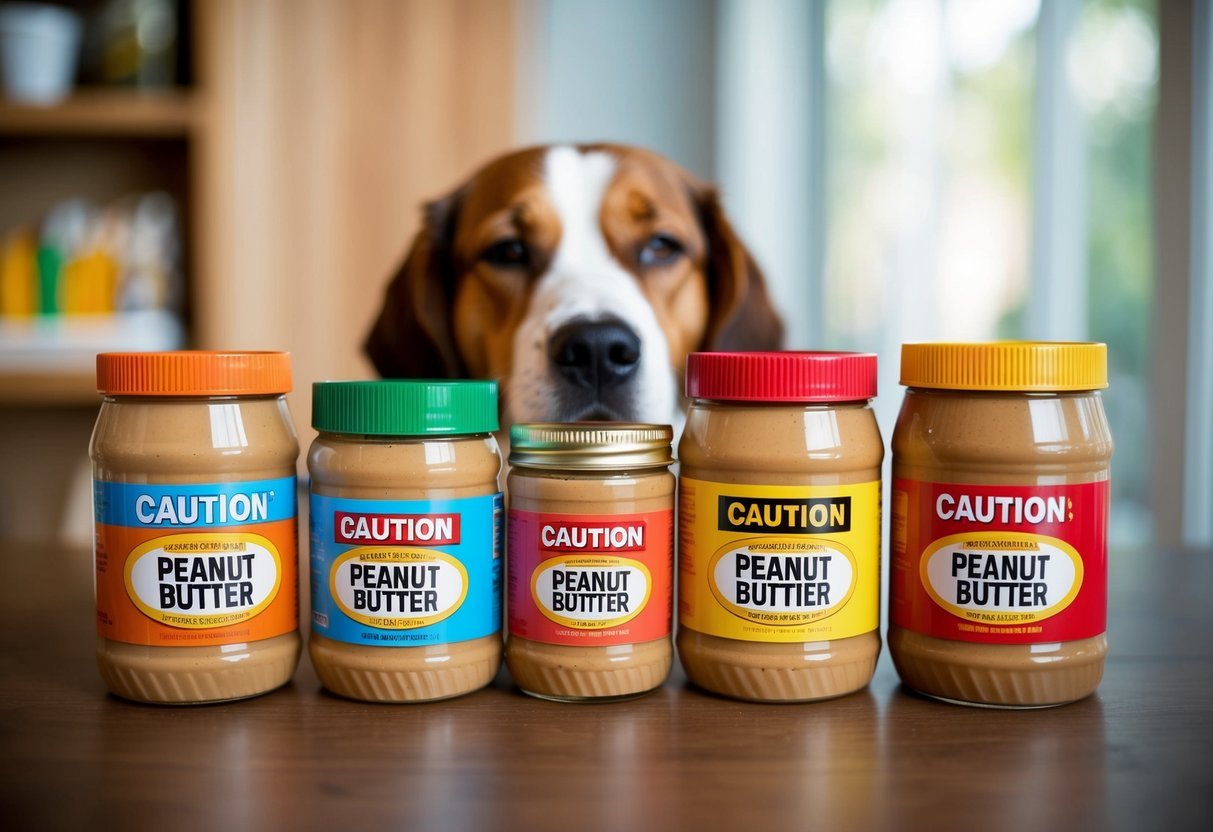
Crazy Richard’s Peanut Butter Powder is a popular choice for people looking for a lighter peanut butter option.
It is made from roasted peanuts, with much of the oil removed.
This peanut butter powder is non-GMO, gluten-free, and vegan, making it a healthy addition to your diet.
While it may be a tasty option for you, it’s crucial to keep in mind that your dog may be sensitive to powdered forms of peanut butter.
The powder contains less fat and fewer calories.
However, when mixed with water, the result is not the same as traditional peanut butter.
It can lack flavor, which might not be appealing to your pup.
Before sharing any peanut butter product with your dog, check the ingredients.
Look for additives and sweeteners that can be harmful to dogs.
Crazy Richard’s Peanut Butter Powder has no added sugar, which is a plus, but always use caution.
Keeping your dog’s health in mind is important.
When introducing new foods, it is best to consult your vet to ensure what you are giving is safe and appropriate for your dog.
Understanding Dog’s Digestive System
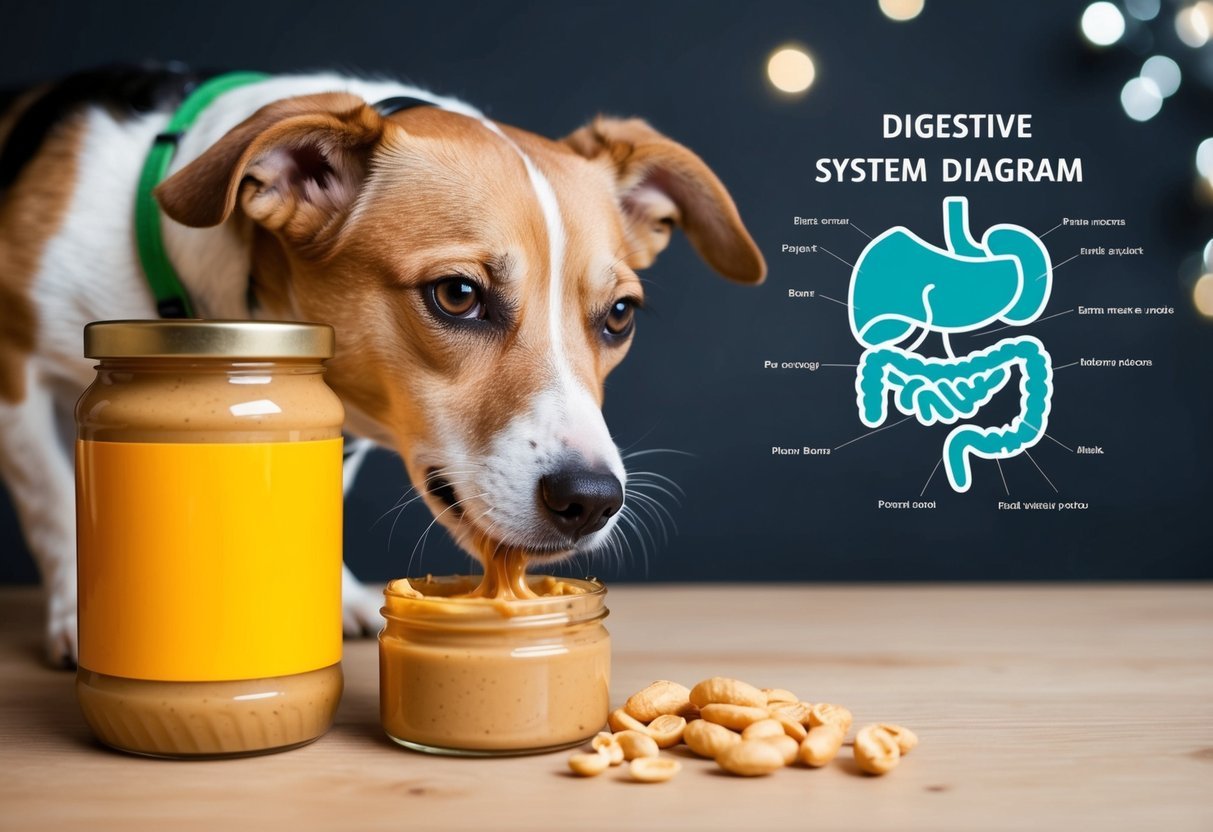
Your dog’s digestive system is different from yours.
It’s important to know how it works to keep your furry friend healthy, especially when it comes to what they eat.
Some foods can be dangerous and cause problems for your dog.
Why Certain Foods Are Harmful
Dogs have a short digestive tract that is designed for meat-heavy diets.
Foods like chocolate, grapes, and onions can be toxic because your dog’s body can’t process them.
For peanut butter, check that it doesn’t contain xylitol, a sweetener that is very harmful to dogs.
Additionally, fatty foods can cause pancreatitis, which is painful and requires medical attention.
Knowing the ingredients in treats, including peanut butter, can help prevent issues that arise from eating the wrong foods.
Common Symptoms of Distress
If your dog eats something harmful, you might notice some signs.
Look for symptoms like vomiting, diarrhea, or signs of pain.
Your dog may also seem lethargic or refuse to eat.
If you notice these symptoms, it’s important to act quickly.
Contact your veterinarian as soon as possible.
Some issues like difficulty breathing or seizures are emergencies.
Keeping an eye on your dog’s behavior after feeding time can help you catch any problems early.
Ingredients in Peanut Butter to Avoid
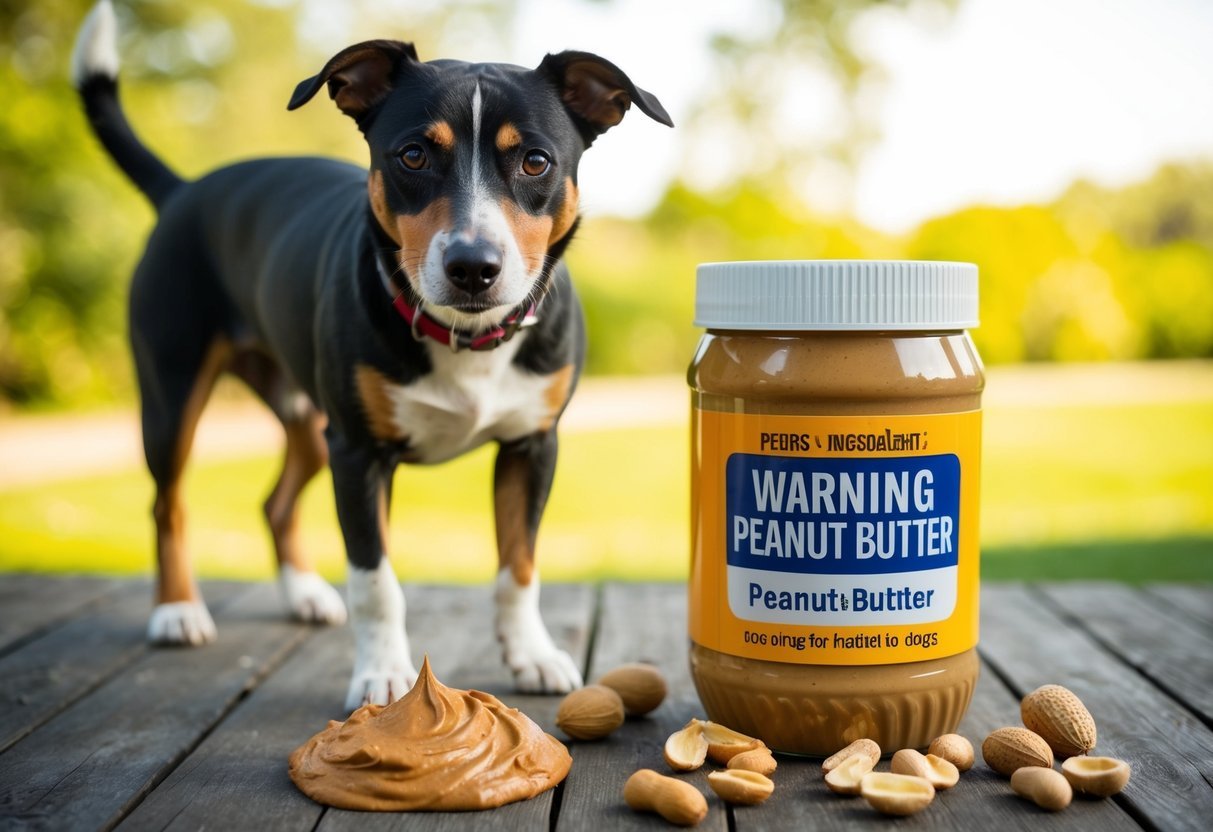
When choosing peanut butter for your dog, it’s important to know what to avoid.
Some ingredients can be harmful and should never be found in your dog’s treat.
Here are key ingredients to watch out for.
Artificial Sweeteners and Additives
One of the most dangerous ingredients is xylitol, a common artificial sweetener found in many peanut butters.
Even a small amount can be toxic to dogs.
It can cause insulin release, leading to hypoglycemia (low blood sugar) and even liver failure.
It’s also wise to steer clear of peanut butter with other artificial sweeteners, like aspartame or saccharin.
These might not be as lethal as xylitol, but they can still upset your dog’s stomach.
Always check the label for any additives that might not belong in your dog’s diet.
Excessive Fats
Some peanut butters are loaded with excessive fats, which can be unhealthy for your dog.
A small amount of fat is fine, but too much can lead to weight gain and associated health issues like pancreatitis.
Look for peanut butter that has a good balance of fats without excessive oils.
Avoid brands that add unhealthy oils or unnecessary ingredients.
Keep in mind that only natural peanut butter with minimal ingredients is usually the best choice.
Reading labels carefully can help you avoid unnecessary fats in your dog’s peanut butter.
Signs Your Dog Ate Peanut Butter
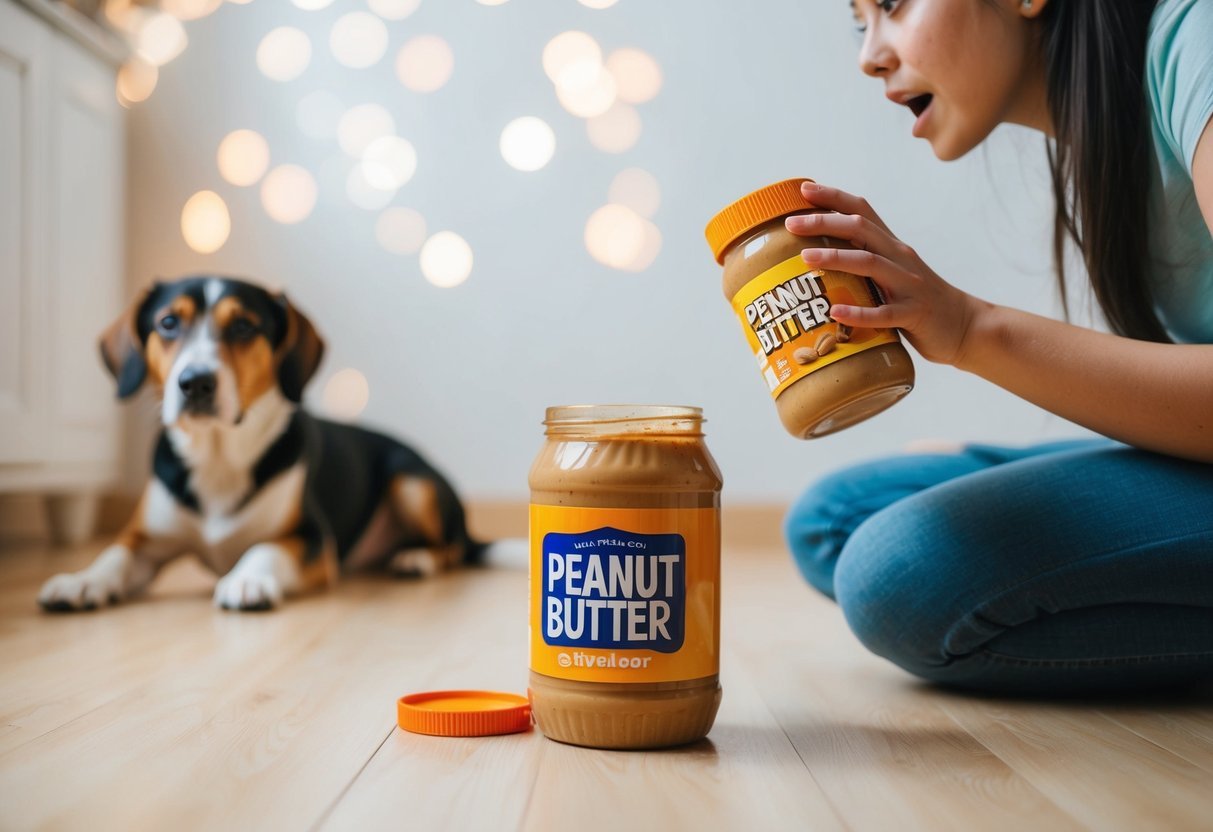
If your dog has eaten peanut butter, it’s important to watch for certain signs.
Here are a few things to keep an eye on:
-
Unusual behavior: If your dog seems more hyperactive or lethargic than usual, this could be a sign something is off.
-
Digestive issues: Look out for vomiting or diarrhea. These can happen if your dog’s stomach doesn’t handle peanut butter well.
-
Allergic reactions: Signs could include itching, hives, or swelling, especially around the face.
-
Breathing difficulties: If your dog has trouble breathing, it could be a serious reaction. Seek help immediately.
-
Excessive drooling: If your dog is drooling more than normal, it might indicate discomfort.
Keep track of how your dog reacts after eating peanut butter.
If you notice any troubling signs, it’s best to contact your vet.
Here’s a quick table to summarize:
| Signs to Watch For | Description |
|---|---|
| Unusual behavior | Hyperactivity or lethargy |
| Digestive issues | Vomiting or diarrhea |
| Allergic reactions | Itching, hives, swelling |
| Breathing difficulties | Trouble breathing |
| Excessive drooling | More drool than usual |
Being aware of these signs can help you keep your furry friend safe and healthy.
Frequently Asked Questions
You might have some questions about giving peanut butter to your dog.
It’s important to know what to look for and what to avoid to keep your furry friend safe and healthy.
Here are some common questions and answers to help you out.
How can I tell if peanut butter is safe for my dog?
To determine if peanut butter is safe, check the ingredients for xylitol, a sugar substitute that is toxic to dogs.
Choose peanut butter with natural ingredients and no added sugars.
Are there benefits to giving my dog peanut butter?
Yes, there are benefits.
Peanut butter is a good source of protein and healthy fats.
It can also make giving your dog medications easier by hiding pills in it.
What should I check on a peanut butter label before giving it to my dog?
Look for the absence of xylitol and high sodium levels.
Avoid brands with added sugars or unhealthy fats.
Choose options that list peanuts as the main ingredient.
Can dogs eat peanut butter that contains dextrose?
It’s best to avoid peanut butter with dextrose.
While it is not as harmful as xylitol, it adds unnecessary sugar.
Stick to peanut butter with minimal ingredients.
Is it true that some peanut butter brands are harmful to dogs?
Yes, some brands can be harmful.
Certain peanut butters, like those containing xylitol or high levels of salt, are not safe.
Brands like Skippy Reduced Fat Peanut Butter and Jif Natural Peanut Butter Spread may have ingredients that are not dog-friendly.
What’s the best type of peanut butter to give to my furry friend?
The best type is unsalted, natural peanut butter with no added sugars or harmful ingredients.
Homemade peanut butter is a great option, as you can control what goes into it.

